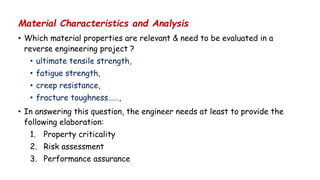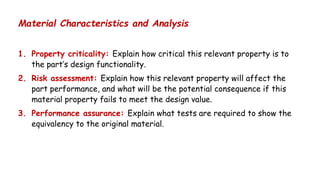Lecture # 08 Reverse Engineering
- 1. BAHIR DAR UNIVERSITY BAHIR DAR INSTITUTE OF TECHNOLOGY (BiT) FACULTY OF MECHANICAL AND INDUSTRIAL ENGINEERING Rapid Prototyping & Reverse Engineering [MEng6123] Reverse Engineering
- 2. Reverse Engineering Definition • It is described in Wikipedia as: • … the process of extracting knowledge or design information from anything man-made. The process often involves disassembling something (a mechanical device, electronic component, computer program, or biological, chemical, or organic matter) and analyzing its components and workings in detail.
- 3. Reverse Engineering Definition • A process of discovering the technological principles of a human made device, object or system through analysis of its structure, function and operation • Systematic evaluation of a product with the purpose of replication. Design of a new part Copy of an existing part Recovery of a damaged or broken part • An important step in the product development cycle.
- 4. Importance • To develop a systematic approach to think about the engineering design of devices and systems • We may not start from the very beginning to develop a new product every time. • We need to optimize the resources available in our hands and reduce the production time keeping in view of the customers’ requirements. • For such cases, RE is an efficient approach to significantly reduce the product development cycle.
- 5. Why Reverse Engineering ? The original manufacturer of a product no longer produces the product The original manufacturer no longer exists, but a customer needs the product. The original design documentation has been lost or never existed. There is inadequate documentation of the original design Some bad features of a product need redesigned. To strengthen the good features of a product based on long-term usage of the product To analyze the good and bad features of competitors' product
- 6. Why Reverse Engineering ? To explore new avenues to improve product performance and features To gain competitive benchmarking methods to understand competitor's products and develop better products The original CAD model is not sufficient to support modifications or current manufacturing methods The original supplier is unable or unwilling to provide additional parts The Original Equipment Manufacturers are either unwilling or unable to supply replacement parts, or demand inflated costs for sole-source parts To update obsolete materials or antiquated manufacturing processes with more current, less-expensive technologies
- 8. • A three-phase process • Scanning, • Point processing, and • Application specific geometric model development. Reverse Engineering–The Generic Process
- 9. Reverse Engineering–The Generic Process • Reverse engineering strategy must consider the following Reason for reverse engineering a part Number of parts to be scanned–single or multiple Part size–large or small Part complexity–simple or complex Part material–hard or soft Part finish–shiny or dull Part geometry–organic or prismatic and internal or external Accuracy required–linear or volumetric
- 10. Reverse Engineering–The Generic Process Phase 1–Scanning/ Digitization of the object/ Data Capturing • This phase is involved with the scanning strategy– • Selecting the correct scanning technique, • Preparing the part to be scanned, and • Performing the actual scanning to capture information that describes all geometric features of the part such as steps, slots, pockets, and holes. • 3D scanners are employed to scan the part geometry, producing clouds of points, which define the surface geometry. • There are two distinct types of scanners, contact and noncontact
- 11. Reverse Engineering–The Generic Process Phase 1–Scanning/ Digitization of the object/ Data Capturing Contact Scanners Employ contact probes that automatically follow the contours of a physical surface Based on Coordinate Measuring Machine (CMM) technologies, with a tolerance range of +0.01 to 0.02 mm.
- 12. Reverse Engineering–The Generic Process Phase 1–Scanning/ Digitization of the object/ Data Capturing Contact Scanners The probes must deflect to register a point; hence, a degree of contact pressure is maintained during the scanning process. This contact pressure limits the use of contact devices for soft, materials such as rubber cannot be easily or accurately scanned.
- 13. Reverse Engineering–The Generic Process Phase 1–Scanning/ Digitization of the object/ Data Capturing Noncontact Scanners Capture data with no physical part contact. Use lasers, optics, and charge-coupled device (CCD) sensors to capture point data Can capture large amounts of data in a relatively short period of time, The typical tolerance of noncontact scanning is within ±0.025 to 0.2 mm. Some noncontact systems have problems generating data describing surfaces, which are parallel to the axis of the laser
- 14. Reverse Engineering–The Generic Process Phase 1–Scanning/ Digitization of the object/ Data Capturing Noncontact Scanners Employ light within the data capture process. This creates problems when the light imposes on shiny surfaces, and hence some surfaces must be prepared with a temporary coating of fine powder before scanning.
- 15. Reverse Engineering–The Generic Process Phase 2– Point Processing • Involves importing the point cloud data, reducing the noise in the data collected, and reducing the number of points. • Allows us to merge multiple scan data sets. Sometimes, it is necessary to take multiple scans of the part to ensure that all required features have been scanned. • This involves rotating the part; hence each scan datum becomes very crucial.
- 16. Reverse Engineering–The Generic Process Phase 2– Point Processing • Multiple scan planning has direct impact on the point processing phase. Good datum planning for multiple scanning will reduce the effort required in the point processing phase and also avoid introduction of errors from merging multiple scan data. • Software packages are generally needed for point processing. • Simplify the data • Polygon meshing • Polygon editing
- 17. Reverse Engineering–The Generic Process Phase 3– Application Geometric Model Development • The generation of CAD models from point data • This phase depends very much on the real purpose for reverse engineering. • For example, if we scanned a broken injection molding tool to produce a new tool, we would be interested in the geometric model and also in the ISO G code data that can be used to produce a replacement tool in the shortest possible time
- 18. Reverse Engineering–The Generic Process Phase 3– Application Geometric Model Development • One can also use reverse engineering to analyze “as designed” to “as manufactured”. • This involves importing the as designed CAD model and superimposing the scanned point cloud data set of the manufactured part. • The RE software allows the user to compare the two data sets (as designed to as manufactured). This process is also used for inspecting manufactured parts. • Defining surface boundaries • Applying NURBS • Exporting the data
- 19. Rapid Prototyping in combination with RE • A group of techniques to quickly fabricate a scale model of a physical part or assembly using 3D CAD data • Integration of reverse engineering and rapid prototyping is being used for getting product to the market quickly by resolving a long-standing conflict between design and manufacturing
- 20. (d) Fabricated RP Model (a) wooden pattern, (b) cloud of points (c) 3D CAD model Rapid Prototyping in combination with RE
- 21. Levels of Analysis in Reverse Engineering 1. System-Wide Analysis 2. Subsystem Dissection Analysis 3. Individual Component Analysis
- 22. System-Wide Analysis • Customer Requirements • Engineering Requirements • Functional Specifications • Prediction of Subsystems and Components
- 23. Subsystem Dissection Analysis • Document Disassembly • Define Subsystems • Determine Subsystem Functional Specifications • Determine Subsystem Physical/Mathematical Principles
- 24. Individual Component Analysis • Repeat Dissection Steps to Individual Component • Define Component Material Selection and Fabrication Process • Suggest Alternative Designs, Systems, Components, and Materials
- 25. Material Characteristics and Analysis • Important for material identification and performance evaluation of a part made using reverse engineering. • One of the most frequently asked questions in reverse engineering is what material characteristics should be evaluated to ensure the equivalency of two materials. • Theoretically speaking, we can claim two materials are “the same” only when all their characteristics have been compared and found equivalent. • This can be prohibitively expensive, and might be technically impossible.
- 26. Material Characteristics and Analysis • Which material properties are relevant & need to be evaluated in a reverse engineering project ? • ultimate tensile strength, • fatigue strength, • creep resistance, • fracture toughness……, • In answering this question, the engineer needs at least to provide the following elaboration: 1. Property criticality 2. Risk assessment 3. Performance assurance
- 27. Material Characteristics and Analysis 1. Property criticality: Explain how critical this relevant property is to the part’s design functionality. 2. Risk assessment: Explain how this relevant property will affect the part performance, and what will be the potential consequence if this material property fails to meet the design value. 3. Performance assurance: Explain what tests are required to show the equivalency to the original material.
- 28. Material Characteristics and Analysis • The mechanical, metallurgical, and physical properties are the most relevant material properties to reverse engineer a mechanical part. • The mechanical properties are associated with the elastic and plastic reactions that occur when force is applied. • The primary mechanical properties include ultimate tensile strength, yield strength, ductility, fatigue endurance, creep resistance, and stress rupture strength.
- 29. Material Characteristics and Analysis • Many mechanical properties are closely related to the metallurgical and physical properties. Metallurgical properties • refer to the physical and chemical characteristics of metallic elements and alloys, such as the alloy microstructure and chemical composition. Physical properties • refer to the inherent characteristics of a material, such as the density, melting temperature, heat transfer coefficient, specific heat, and electrical conductivity.
- 30. Material Characteristics and Analysis Material Identification and Process Verification • Material identification and process verification are essential to reverse engineering. • Involves analyzing chemical composition, microstructural characteristics, grain morphology, heat treatment, and fabrication processes. • The chemical composition of a material determines its inherent properties. • The microstructural characteristics are closely related to a material’s mechanical properties. • Grain morphology reveals the grain size, shape, texture, and their configuration in a material.
- 31. Material Characteristics and Analysis Composition Determination/Identifying alloying Elements • Mass Spectroscopy • Inductively Coupled Plasma–atomic Emission Spectroscopy • Electron Specimen Interaction and Emission • X-ray analysis
- 32. Material Characteristics and Analysis Microstructure Analysis • The chemical composition shows what an alloy is made of. • Microstructure is an alloy’s footprint that traces back its heat treatment history and fabrication flow path, and shows how this alloy is manufactured. • Light Microscopy • Scanning Electron Microscopy • Transmission Electron Microscopy
- 33. Material Characteristics and Analysis Manufacturing Process Verification • The four primary parameters in manufacturing are temperature, time, force, and atmosphere, such as the solution heat treatment temperature, aging treatment time, force used in forging or press, and atmosphere in which the part is cast or welded. • .
- 34. Material Characteristics and Analysis Manufacturing Process Verification • The macro-structural appearance, such as surface finish, and microstructural features, such as grain morphology of the finished parts, usually provide the first evidence of how they are made. • Therefore, reverse engineering, a manufacturing process, often starts with macrostructure examination and microstructure analysis to determine the temperature, time, force, and atmosphere that the Original Equipment Manufacturer (OEM) used to produce the original parts.
- 35. Material Characteristics and Analysis Manufacturing Process Verification • The three most utilized manufacturing processes to produce mechanical components are casting, product forming, and machining. • To assemble individual parts together, many joint methods are used, such as soldering, blazing, and welding. • To improve the strength and performance of the product, many engineering treatments, such as heat treatment and surface treatment, ranging from coating to shot peening, are commonly applied. ……… ??? ……
![BAHIR DAR UNIVERSITY
BAHIR DAR INSTITUTE OF TECHNOLOGY (BiT)
FACULTY OF MECHANICAL AND INDUSTRIAL
ENGINEERING
Rapid Prototyping & Reverse Engineering
[MEng6123]
Reverse Engineering](https://image.slidesharecdn.com/lecture08-201226210052/85/Lecture-08-Reverse-Engineering-1-320.jpg)
















































































































